MONTREAL – With the 2015-16 CONCACAF Champions League group stage kicking off Tuesday, stories of long trips, hostile environments and “CONCACAF’ing” will unfold. Some will be told. Others will be withheld.
This is the forgotten story of the Montreal Impact’s run to the 2014-15 CCL final. It involves a coin and some ingenuity. And no names have been changed to protect the guilty.
Amid the glory days that peppered Montreal’s path to the final, it is often forgotten that the team put in some more tiring days abroad to even get ready for the knockout rounds – 17 of them in total in Mexico City and Pachuca.
Some staff members spent even more time there, away from friends and family. It grew tiresome for the likes of Aldo Ricciuti, the equipment manager, Eduardo ‘Lalo’ Ceza, the assistant equipment manager, and Daniel Pozzi, the team operations manager.
“We were driving to the field before a training session,” Ricciuti told MLSsoccer.com. “I was with Danny Pozzi and Lalo, and we were just saying ‘What could we do to make this more interesting, funnier – bring some luck to us.’”
To many Canadians, the ultimate lucky charm in sports is the “Lucky Loonie” from the 2002 Salt Lake Olympics. Canadian icemakers had been hired to build the Olympic ice hockey rink. They buried a one-dollar coin at center ice. A select few knew of the secret, including the members of the Canada men’s and women’s national ice hockey teams. Both teams won gold.
Pozzi remembered the story in the car and, along with Ricciuti and Ceza, drew inspiration from it.
“We scrambled to find a loonie,” Pozzi said.
Added Ricciuti: “I had one, actually, in my room. We decided this on the day before the Pachuca game.”
But the trio was most certainly not in charge of the grass at Pachuca’s Estadio Hidalgo. They had to somehow stick the coin into the grass just before the game, with camera crews around and fans starting to walk in.
Before warm-ups, Ricciuti, Pozzi and Ceza entered the field and pretended that they were merely checking it, kneeling down at certain spots. At center circle, Ricciuti dug a slit into the grass with his fingers and implanted the loonie.
It stayed there the whole game.
Montreal achieved a 2-2 draw that would prove crucial. Ricciuti then told Ignacio Piatti to retrieve the loonie. Piatti didn’t believe Ricciuti at first, but eventually would become his accomplice, recovering the coin five more times.
For the return leg at Montreal’s Olympic Stadium, Ricciuti had a problem: turf can’t be dug into like grass. But it’s always possible to work your way around the several panels of turf laid down, finding seams. Ricciuti managed to slip the loonie underneath the surface on the day of the game.
Cameron Porter’s last-gasp equalizer qualified Montreal for the semifinals. Calum Mallace’s long assist flew right over the loonie.
Fifteen days later, with the dollar hidden under the Big O turf once more, Montreal defeated Costa Rica’s Alajuelense by a 2-0 scoreline in the first leg of the semis. The second leg was a trickier matter, loonie-wise. It was nearly impossible to replicate the Pachuca strategy in Alajuela – the Estadio Alejandro Morera Soto's surface is artificial turf, too.
The trio opted to wait for media to leave training on the eve of the game and sneak the loonie under the turf. Only, someone from Alajuelense could easily have seen them, threatening the good luck charm’s existence.
The next night, the atmosphere was hostile as can be. Anyone wearing the Impact crest was roundly whistled at and booed in the stadium – anyone. The three colleagues got duly abused as they went to see if the loonie was still there. Ceza took care of the (brilliant) distraction.
“Lalo says, ‘I’m going to go look at the crowd,’” Ricciuti said. “And he picked up his phone and started filming the crowd. People were yelling at him even more, and everybody was focusing on him. So no one was looking at the middle of the field.”
Their shenanigans from the previous day had gone unnoticed. Montreal got the result they needed again, losing 4-2 but squeaking through to the final on away goals. The loonie was more and more effective, and most importantly, the secret was kept from the other teams. Only the players and some fans – Ricciuti isn’t sure about the Impact coaching staff – knew.
“The thing that I was a little more worried about was if there was a tackle at center field and the loonie would have popped out,” Ricciuti said. “That was my biggest worry. You never know. I don’t think anything bad would have happened, especially at Alajuelense. They were throwing coins at us anyway!”
The first leg of the final against Club América was the easiest setting for Ricciuti to hide the coin. As in Pachuca, he scratched a hole into the grass and buried the loonie there. As in Alajuela, he could afford to do it on the eve of the game, after the media had left the training session at Estadio Azteca.
Piatti recovered the loonie again the next day, after he’d scored in a 1-1 draw that shocked the Azteca crowd. It was the last time he’d do that with a smile on his face. The spell was broken a week later at Olympic Stadium, as América ran out 4-2 winners on the night, 5-3 on aggregate.
“The loonie was spent,” Pozzi said. “There were no quarters left in it.”
They may use a toonie, Canada’s two-dollar coin, next time.
“Obviously a dollar wasn’t enough, we need a little more,” Pozzi said.
They’ll have to find another spot on the field – teams will watch their center circle. Oh, and they’ll have to beat Vancouver in the Amway Canadian Championship final, later this month, to reach CCL again regardless.
In which case, it'll be money well spent.




